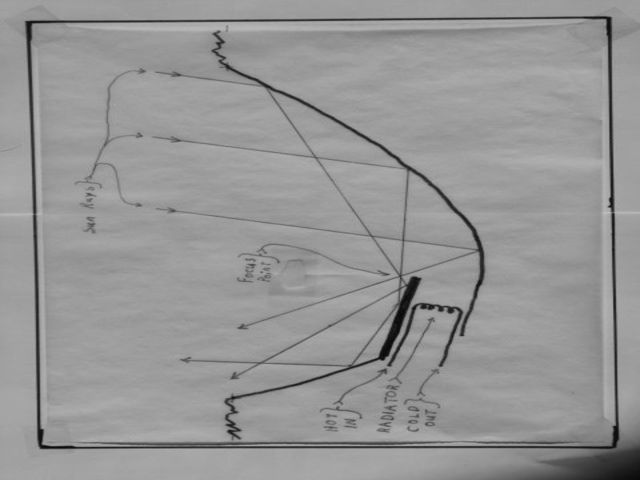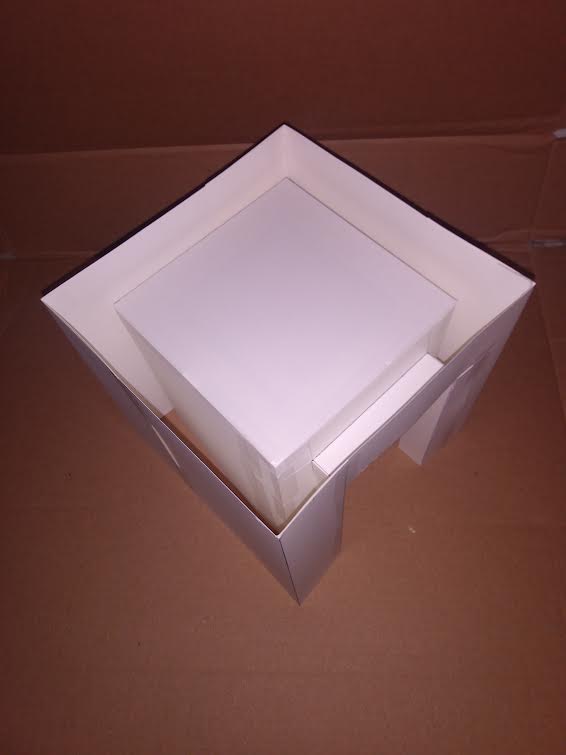User:Farred/test
I intend to upload a picture here.
This charming image does not convey the words included in the original work because of insufficient resolution. On the left edge of the image from top down are the words:"HOT IN", "RADIATOR" and "COLD OUT". Arrows from the words point to features in the picture. On the top are the words: "Sun Rays". In the middle of the image are the words focus point. The image is a cross section of a parabolic ditch on Luna running East and weast at the 13 degree North latitude. The projetion of sun rays into the plane of the image is always tilted about 13 degrees to the right of vertical, ranging from 11.5 to 14.5 degrees from vertical. South is to the right. The radiator is always protected from sunlight, from infra red radiation from the surroundings and from micrometeoroids. The image is not intended to be to scale of an actual device, but merely to communicate the concept.
What can be built on the moon soon is a thermal shelter for remote controlled devices. Naturally, if a device sent to do work on the moon fails because it is vulnerable to the overnight low temperature of the two week long lunar night, it will not accomplish much work on the moon. It should be possible for a remotely controlled device to assemble a thermal shelter out of prefabricated pieces during the lunar day so it can be sheltered during the night and work again next day.
The lunar regolith is good insolation on the moon where it exists in a vacuum. At a depth of a foot or more in fine particles there is no great variation in temperature from day to night. A shelter could be covered with a foot of fines for insulation making good thermal protection. A door to the shelter could be made from prefabricated panels with a 14 inch hollow space between them. The space could be filled with sifted regolith fines for great insulation. The door could be carried by a remote controlled device on the moon as it enters the shelter it assembled. The door would be left at the doorway of the shelter to complete the thermal insulation.
Reasonably inexpensive (relative to other space probes) and simple devices could use such a shelter on the moon and survive the night to work again the next day.
Thermal Shelter on the moon
The thermal shelter on the moon that people should be concerned with now is a shelter for remotely controlled machines. To be economicly effective, such machines must last more than two weeks, the length of time from sunrise to sunset on the moon. The Chinese made a machine last over night and continue working month after month. They used chuncks of radioactive material, (probably plutonium 238), to provide heat and a small amount of electrical power during the sunset to sunrise period. This tactic makes maintaining a cool enough temperature for operation during the sunrise to sunset period more difficult, and it is rather expensive. The thermal shelter concept I feature here is a double walled building as shown by the model photograph. The outer wall is 8 feet by 8 feet at the foundation and 8 feet high. With the inner wall, doorway, lintel, roof and six "V" cross section roof support girders (not shown because they are hidden by the roof) that comes to 550 square feet of cardboard including 38 square feet for slot and tab construction technique with prefabricated pieces. If I take a popular grade of cardboard and consider charring it to 40 percent of its original weight I get 23 square feet per pound. That makes about 24 pounds of charred cardboard for the building walls, 6 pounds for the 400 buttons strings and tensioners that will fasten the inner and outer walls together that need to be shipped to the moon for the building and no weight that needs to be shipped to the moon for the sifted regolith fines that will fill the spaces between the inner and outer wall, cover the roof and act as insulation because the regolith fines are already on the moon wherever the thermal shelter needs to be built.
Venus cooled to 0 degrees Centigrade
On Venus at 0 degrees Centigrade about 53 % of the atmosphere would remain as a gaseous CO2 providing the 49 bar pressure to liquify the 47% of the atmosphere that would fill the carbon dioxide ocean. The 3.5% nitrogen originally in the atmosphere would make up about 6.6% of the atmosphere remaining or about 22% by volume. Would people be able to fly a reentry vehicle to the surface under these conditions to make a base and mine the solid surface of Venus? A shade for cooling the planet Venus could be made out of stuff mined from Earth's moon. The accuracy of the numbers is low.









